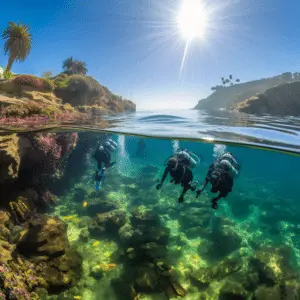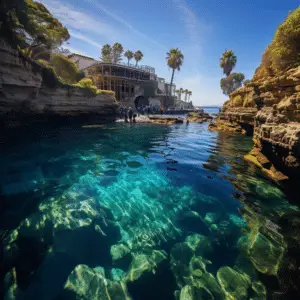The Pacific offshore in San Diego is a visitor’s playground both above and underwater. From the Scripps Canyons to the Matlahuayl State Marine Reserve– a 10-mile long and 3-mile wide stretch of ocean. Across the giant kelp forests in Point Loma, and even a 533-acre aquatic Ecological Reserve just outside of the La Jolla Cove. Visitors surely won’t run out of activities to do in San Diego.
The La Jolla Shores is considered as a gateway to the underwater park– a diver’s Mecca. They have a wide variety of fantastic sea life that one won’t want to miss. It is a flat and sandy beach that is one mile long and straight offshore, making it perfect for beginners. Expert divers can also enjoy diving the La Jolla for the dark blue depths and seemingly unlimited ways to explore the La Jolla Submarine Canyon.
A lot of retired Navy SEALS and divers live in the area, therefore, it is filled with diving experts who have spent their fair share of time in its waters. The beaches along the La Jolla coastline serve as the hub of San Diego shore diving. No matter where you decide to dive in San Diego, it’s always an adventure filled with marvelous sights and majestic underwater seascapes. And of course, one cannot talk about San Diego without mentioning the La Jolla Coves.
La Jolla History

The surrounding areas around La Jolla Cove were once called La Jolla Park but were subsequently renamed Ellen Browning Scripps Park in the late 1920s as a recognition for the contributions she made to Scripps and La Jolla. The La Jolla Cove is part of the Matlahuayl State Marine Reserve– its name Matlahuayl roughly translates to land of holes and is a tribute to the Kumeyaay tribes that used to live in this area.
Surrounded by sandstone cliffs along the San Diego coastline lies a small beach known as the La Jolla Cove. Although small, it is known as one of the most famous dive sites in San Diego. The La Jolla Cove is considered as one of the most photographed beaches in SoCal.
The north facing La Jolla Cove is ideal for swimmers, snorkelers, scuba divers, underwater photographers, videographers, deep divers and night divers alike due to its small surf in the summer months and the water visibility exceeds to 30 feet.
Aside from its stunning beauty above water, the world found under the cove is a stunning one made up of interesting reef areas, caves, and kelp. Since it is part of the La Jolla Park Ecological Reserve, there is an abundance of marine wildlife that can be found in the cove. Taking of any kind– be it fish, mollusks, or any other marine resources– is strictly prohibited in the cove and its surrounding areas.
La Jolla Cove is also one of the few places in the golden state where you can find giant kelp beds, rocky reefs, and sea caves all in a single beach. You can even go diving with sea lions if they are in the mood for it.
Marine Conservation
La Jolla Cove and its surrounding waters are part of the Matlahuayl State Marine Reserve and have been a protected area since the 1920s. The decades-long effort of conserving the cove is well worth it because it has since flourished with varied marine life. The upwelling from the nearby La Jolla Submarine Canyons results in nutrient-rich water, which in turn sustains its marine biodiversity.
A number of harbor seals can be often lounging on the beach and occasionally join divers on their descent, sometimes alongside them or even faster than them. Sometimes they just like to prove who’s the better swimmer.
Commercial, recreational, and spear finishing is not allowed within the boundaries of Matlahuayl Reserve– this means that hunting and capturing of marine mammals and other aquatic life is strictly prohibited. The removal of rocks, shells, and other minerals is also not allowed.
There are two other adjacent conservation areas to the north and south. To La Jolla Cove, along with the Matlahuayl Reserve. This creates a safe passageway and shelter for the wide variety. Underwater creatures that frequent the area, including different kinds of fish, mammals, and other invertebrates. Some deep water creatures can also be seen occasionally in the cove, like the broad nose sevengill shark.
We have compiled a shortlist of some of the most popular and commonly seen wildlife at the cove:
- Fish: Blacksmith, California Sheephead, California Moray, Garibaldi, Kelp Bass, Opaleye, Sargo, Surfperch
- Sharks and Rays: Banded Guitarfish, Horn Shark, Leopard Shark, Round Stingray
- Other Marine Mammals: Brandt’s Cormorant, California Sea Lion, Green Sea Turtle, Harbor Seal
- Marine Birds: Brandt’s Cormorant, La Jolla Brown Pelican
- Invertebrates: California Spiny Lobster, Kelp Snail, Ochre Sea Star, Sheep Crab
- Algae and Seagrass: Braided Hair Algae, Eelgrass, Feather Boa Kelp, Giant Kelp, Surfgrass
Diving
Diving in California waters is far from the warm waters at your usual tropical dives. The waters in California are significantly cooler, and the visibility is often less than 30 feet. The water temperature in La Jolla Cove typically ranges from around 53°F to 663°F. But on warm summer days, the water temperature can usually reach up to 78°F. It’s warmest during the fall, which is usually around early September to late November.
The La Jolla Cove can be a bit difficult to navigate because its visibility is unpredictable. It usually ranges from 10 to 20 feet but sometimes reaches up to 40 feet on its best days. Its cold waters, while full of nutrients and microorganisms cloud up the water resulting in poor visibility. Strong surf is also a factor.
The surge at the cove isn’t dangerous at all– mostly light to moderate– but it’s best to take caution if you’re unfamiliar with the underwater landscape of the area. The sea caves can also be dangerous during a moderate surge. If you’re not careful, a large swell could push you against the several rock outcroppings hidden just underneath the water.
Having an excellent quality and safe diving experience in La Jolla can depend on a lot of conditions, including weather, visibility, swell and surge. So it is best to visit during the most optimal times of the year.
Site Features
La Jolla Cove diving is also featured as the Top Pick location for scuba diving in California.
The Cove
The cove itself is 10 to 20-foot deep rock reefs with lots of aquatic marine life hanging about– like schools of fish, garibaldi, and horn sharks. Different kinds of crabs– like sheep and kelp crabs, lobster, kelp bass and giant. Kelpfish can also be seen around the area. Keep your eyes open for bat rays and the occasional non-horn shark. It’s also common to find halibut, rays, and guitarfish in the shallow waters along the shoreline.
The Rockpile
The sand floor located in the southern part of the cove turns into beautiful, seagrass-covered rocks. In the summer months, hundreds of leopard sharks can be seen swimming in this area. Stingrays often love to hide along the sandy floors at the cove, so watch out for them when you enter the water. The kelp is where giant sea bass, soupfin sharks, and broad nose sevengill sharks are sometimes seen.
The Kelp Beds
California is known for its lush kelp forests, and the La Jolla Kelp Forest is among the largest and healthiest in SoCal. It is formed by an expansive bed of giant. Kelp that rises from the rocky bottom all the way to the surface, forming an underwater forest you can swim through. Plenty of fishes, sharks, and pinnipeds frequent these forests. It’s a treasure trove for underwater photographers. There’s no other experience quite like it.
Boomer
Southwest of the cove, past the western border of the marine sanctuary, divers can find Boomers– aptly named because of the sound the waves make. On calmer days, divers will be able to explore great rock reefs that form long passageways along its jagged walls. These boomers are a favorite playground for baby seals, and the waters surrounding it are frequented by gray whales who come here to breach.
The Cliffs and Caves

On calm days, divers will be able to explore what is known as the ancient Seven Caves. It has a variety of swim-throughs that barrel through the rock and spacious grottos. The caves are mostly shallow, with wide, open-air chambers that are easy to come to the surface. Hundreds of sea lions love to sunbathe on the rocky cliffs above caves and play in the nearby waves.
Seagrass Meadow
The shallowest part of the cove is a seagrass meadow where beds of surfgrass and eelgrass thrive and flourish. It either clings to underwater rocks or grows in the sand. When diving here, be on the lookout for nudibranchs, sea stars, and young fishes.
